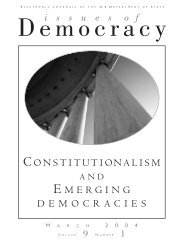Terrorism: Threat Assessment, Countermeasures and Policy
Terrorism: Threat Assessment, Countermeasures and Policy
Terrorism: Threat Assessment, Countermeasures and Policy
Create successful ePaper yourself
Turn your PDF publications into a flip-book with our unique Google optimized e-Paper software.
During the 1990s, perhaps only one other (presumably<br />
unrelated) terrorist incident evidenced those same<br />
characteristics of coordination <strong>and</strong> high lethality: the<br />
series of attacks that occurred in Bombay in March<br />
1993, where a dozen or so simultaneous car bombings<br />
rocked the city, killing nearly 300 persons <strong>and</strong><br />
wounding more than 700 others. 3 Indeed, apart from<br />
the attacks on the same morning in October 1983 of<br />
the U.S. Marine barracks in Beirut <strong>and</strong> a nearby French<br />
paratroop headquarters, <strong>and</strong> the IRA’s nearsimultaneous<br />
assassination of Lord Mounbatten <strong>and</strong><br />
remote-control mine attack on British troops in<br />
Warrenpoint, Northern Irel<strong>and</strong>, in 1979, it is hard to<br />
recall many other significant incidents reflecting such<br />
operational expertise, coordination <strong>and</strong> synchronization.<br />
WHERE WE WENT WRONG IN FAILING TO<br />
PREDICT THE 9/11 ATTACKS<br />
Accordingly, we were perhaps lulled into believing that<br />
mass, simultaneous attacks in general, <strong>and</strong> those of<br />
such devastating potential as we saw in New York <strong>and</strong><br />
Washington on September 11th, were likely beyond<br />
most capabilities of most terrorists — including those<br />
directly connected to or associated with Osama bin<br />
Laden. The tragic events of that September day<br />
demonstrate how profoundly misplaced such<br />
assumptions were. In this respect, we perhaps<br />
overestimated the significance of our past successes<br />
(e.g., in largely foiling most of bin Laden’s terrorist<br />
operations during the period between the August 1998<br />
embassy bombings <strong>and</strong> the November 2000 attack on<br />
the USS Cole) <strong>and</strong> the terrorists’ own incompetence<br />
<strong>and</strong> propensity for mistakes (e.g., Ahmad Ressam’s<br />
bungled attempt to enter the United States from<br />
Canada in December 1999). Indeed, both more<br />
impressive <strong>and</strong> disturbing is the fact that there was<br />
likely considerable overlap in the planning for these<br />
attacks <strong>and</strong> the one last November against the USS<br />
Cole in Aden: thus suggesting a multi-track operational<br />
<strong>and</strong> organizational capability to coordinate major,<br />
multiple attacks at one time.<br />
Attention was also arguably focused too exclusively<br />
either on the low-end threat posed by car <strong>and</strong> truck<br />
bombs against buildings or the more exotic high-end<br />
threats, involving biological or chemical weapons or<br />
cyber-attacks. The implicit assumptions of much of<br />
our planning scenarios on mass casualty attacks were<br />
that they would involve germ or chemical agents or<br />
result from widespread electronic attacks on critical<br />
infrastructure <strong>and</strong> that any conventional or less<br />
extensive incident could be addressed simply by<br />
planning for the most catastrophic threat. This left a<br />
painfully vulnerable gap in our anti-terrorism defenses<br />
where a traditional <strong>and</strong> long-proven tactic — like<br />
airline hijacking — was neglected in favor of other, less<br />
conventional threats, <strong>and</strong> the consequences of using an<br />
aircraft as a suicide weapon seem to have been almost<br />
completely discounted.<br />
In retrospect, it arguably was not the 1995 sarin nerve<br />
gas attack on the Tokyo subway <strong>and</strong> nine attempts to<br />
use bio-weapons by Aum that should have been the<br />
dominant influence on our counterterrorist thinking,<br />
but a 1986 hijacking of a Pan Am flight in Karachi,<br />
where the terrorists’ intentions were reported to have<br />
been to crash it into the center of Tel Aviv, <strong>and</strong> the<br />
1994 hijacking in Algiers of an Air France passenger<br />
plane by terrorists belonging to the Armed Islamic<br />
Group (GIA), who similarly planned to crash the fuelladen<br />
aircraft with its passengers into the heart of Paris.<br />
The lesson, accordingly, is not that we need to be<br />
unrealistically omniscient, but rather that we need to be<br />
able to respond across a broad technological spectrum<br />
of potential adversarial attacks.<br />
We also had long consoled ourselves — <strong>and</strong> had only<br />
recently begun to question <strong>and</strong> debate the notion —<br />
that terrorists were more interested in publicity than<br />
killing <strong>and</strong> therefore had neither the need nor interest<br />
in annihilating large numbers of people. For decades,<br />
there was widespread acceptance of the observation<br />
made famous by Brian Jenkins in 1975 that, “Terrorists<br />
want a lot of people watching <strong>and</strong> a lot of people<br />
listening <strong>and</strong> not a lot of people dead.” 4 Even despite<br />
the events of the mid-1980s — when a series of highprofile<br />
<strong>and</strong> particularly lethal suicide car <strong>and</strong> truckbombings<br />
were directed against American diplomatic<br />
<strong>and</strong> military targets in the Middle East (in one instance<br />
resulting in the deaths of 241 Marines) — many<br />
analysts saw no need to revise these arguments. In<br />
1985, Jenkins, one of the most perspicacious <strong>and</strong> acute<br />
observers of this phenomenon, again noted that,<br />
3 . Celia W. Dugger, “Victims of ‘93 Bombay Terror Wary of U.S. Motives,” New<br />
York Times, 24 September 2001<br />
4. Brian Michael Jenkins, “International <strong>Terrorism</strong>: A New Mode of Conflict” in<br />
David Carlton <strong>and</strong> Carlo Schaerf (eds.), International <strong>Terrorism</strong> <strong>and</strong> World Security<br />
(London: Croom Helm, 1975), p. 15.<br />
23












